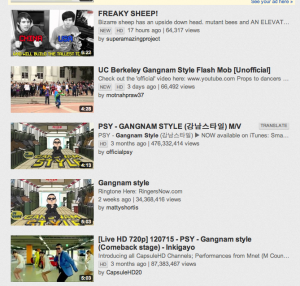Want to Rank on YouTube Search? Keep the Audience.
Update on 10/19/12: Apparently YouTube is counting raw minutes not percent of video as I have indicated. According to this source a video will rank more highly based on total minutes viewed — even above a video with more views that were shorter.
YouTube, the second largest search engine, is increasingly following the “Google” approach to ranking — not by tags/total views but by relevance — as defined by duration of average view relative to other videos of the same duration.
But there’s an important part of this definition that seems to be escaping many people. Jump to the pop quiz to see if you understand it.
This emphasis on view duration isn’t entirely new, but it’s an accelerated shift from the ranking criteria of the past. For instance, in 2005-2007 a video creator could influence a video’s search ranking on YouTube (and even Google) simply by: a) tagging a video well, b) giving the video an irresistible thumbnail, and c) ensuring the video got lots of views out the gate. Then it would get “stuck” as a top result since views beget views.
So this isn’t very surprisinge: YouTube is ranking less on total views & metatags and more on “engagement” (as defined by view duration). I’ve long been predicting that YouTube would rank based on “stickiness” of the video — how long it’s viewed. After all, a viewer that stays watching has, presumably, found content that’s relevant. That’s the Google way.
What I didn’t predict was that YouTube might “full throttle” view duration — arguably misbalancing the results based primarily and almost exclusively on view duration. I also may have missed the true motive of this change. Remember that this change is in the context of YouTube shifting its content strategy toward professional and longer-form content. Motive? You bet.
Let me get more specific, however, as to how this shift can screw up the search. This article is titled “How YouTube Just Screwed Gangnam Style” (the music video that’s become such a viral cliche I have avoided writing about it). Below is a graphic representation of the YouTube search results for a search on “Gangnam Style.” You would expect to see the official video first, but it’s not. It’s buried behind copycats and parodies.
(Fortunately you can find the official video if you select “refine” by the search box, and choose “most viewed.” But how many people are savvy enough to refine a search? When’s the last time you refined a search on Google? We don’t do it. We’re not even encouraged by Google/YouTube to do it).
View duration has, in reality, been increasingly important for several years– just not at today’s level. For instance, CharlesTrippy and Shaytards are two daily vloggers who figured out the importance of long videos 2-3 years ago. Their 10-15 minute daily videos get nice ranking (spotlights/most viewed) and views — and that’s because their loyal audiences will watch the vloggers as if it’s a commercial-free reality show (without script writers). Their loyal fans stick around longer than they might when watching other 10-15 minute videos.
Part of me loves this change– search for “Cute Kitten” on YouTube and my “I Are Cute Kitten” video is now ranked #1. People tend to keep watching due to the hypnotic music and cuteness.
Part of me doesn’t love this change — my Fart video, once the first result under a search for Fart on Google, has dropped dramatically in the past year. It takes a while to build, so casual viewers probably jump with lack of patience.
So what does this mean for viewers and creators?
- Viewers should probably refine searches until the view duration isn’t overpowering the algorithm. I do believe the algorithm will correct itself as Google learns from searches and researches (the latter creates a punitive mark on the former result).
- Creators, as always, better hold onto their audience… have a cliff hanger, keep them engaged in the first critical 10 seconds when they’ve got their mouse on the “close” button.
- Duping the viewer won’t work. If your video doesn’t pay off the promise of the title and thumbnail you are screwed.
- Don’t fear long videos. You just need to keep people engaged for longer than is typical. For instance, if people typically watch 5 minutes of a 30-minute video (17%)… if you keep them for 7 or 10 minutes, you’re at an advantage.
- Finally, keywords still matter. Google/YouTube’s results have to start with the text terms, then factor in view duration. For instance, my “Farting in Public” wouldn’t be in the ‘consideration basket’ for a search of the word “Fart” if it didn’t have fart in the title and tag. But it will eventually rise or fall based on how long people stay.
Here’s the pop quiz. What would likely give you better search ranking, assuming all other things are equal (video thumbnail, metatag, views to date).
- A video that kept viewers for one minute on a 2-minute video (50%) or
- keeping them for 5 minutes on a 20 minute video (25%).
Counter intuitely, the latter may rank your video higher. This would be true if 5 min out of 20 (25%) is better than the average view duration of other videos that are 20 minutes long. Simply put, if most people stick around an average 3 minutes on a 20-minute video — and you keep them longer… you’re above average.
This is what I believe most people overlook — YouTube isn’t necessarily looking for a higher than average total view in absolute. It’s looking at the percentage of the video that is consumed relative to videos of similar length. That’s why Trippy and Shay have done well… the vast majority of us will ditch a video that’s 10-15 minutes. If the vloggers’ loyal viewers do better than average (say even keeping them 30% of the time or 5 minutes) they’re likely to rank higher on searches for the topic of their video.
Make sense? Any questions? How’d you do on the quiz?



Want to Rank on YouTube Search? Keep the Audience.: YouTube, the second largest search engine, is increasingly f… http://t.co/1yCaUrwW
Want to Rank on YouTube Search? Keep the Audience. http://t.co/dSkWfrxm
Want to Rank on YouTube Search? Keep the Audience. http://t.co/EI77i61Z
This is quite intriguing. Working at a small marketing firm that specializes in SEO and video, we tend to advise clients that shorter videos are more powerful because they keep the audience’s attention, however, the content/images/music you are infusing into that video need to be done so strategically. So I understand what you are saying, but the notion that duration is trumping views or shares is interesting and quite different from what recent articles suggest on the subject. I wonder if YouTube Analytics will change their makeup and analysis they provide to better conform to this new set up. http://framevine.com/youtube-analytics/
RT @nalts: Want to Rank on YouTube Search? Keep the Audience. http://t.co/uVzJi499
RT @nalts: Want to Rank on YouTube Search? Keep the Audience. http://t.co/uVzJi499
Thanks for another great article.
By the way, can you maybe write a piece on this new hit video and why it is so successful?
https://www.youtube.com/watch?v=Bn09g1bwgDc
It does have a catchy title and girls in bikinis in the thumb, but why did it become such a mega-hit unlike similar videos?
Great post, I landed here after watched a reelseo video on this topic, I think it’s a good move ranking videos based on how long people watch a video, hopefully it will push the really poor videos down the list.
I also think that the video’s engagement value is based upon how well it does compared to videos of similar length… but is there any ‘official’ wording that tells us that from YouTube? Or are we guessing that is the case because the ‘Audience retention’ tool uses that type of comparison for one of its measurements?
Or maybe it is simply ‘number of minutes watched’ for a certain keyword regardless of comparisons to other videos of any length?